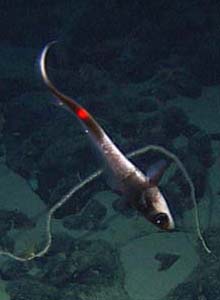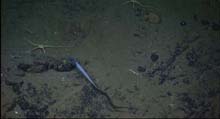
A grenadier in a head-down posture uses current flow to travel over the seafloor in search of prey. Click image for larger view.
Fishes in Flow
Peter Auster
Fish Biologist
University of Connecticut
Seamounts rise from abyssal depths into the midwater realm of the deep sea, interrupting the flow of deep ocean waters. These islands of hard substrate cause the acceleration of water flow around and over them, creating a unique hydrodynamic environment for fishes. The diversity of species that occur around seamounts has a range of shapes that vary in efficiency in terms of energy required to maneuver in current flows. Such differences between species, and between size classes within species, can have profound effects on how fishes are distributed within these deep sea landscapes.
Fishes exhibit a number of foraging strategies for operating in regions with high flows. Some use a sit-and-wait strategy where they either rest on the seafloor or use slow rhythmic swimming movements to stay in place over or near a seafloor feature. In this situation, the fish 'ambush' zooplankton or small fishes as they drift by in the current. That is, the higher the current speed the greater the frequency that prey animals drift by. This leads to a trade-off in the energy needed by the predator to stay in place versus the amount of energy consumed as prey. Also, there are constraints on the ability of fishes to maneuver in increasingly strong flows. For example, research on shallow water coral reef fishes has shown that the 'zone' where a predatory fish can control swimming to capture prey decreases as flow rates increase. Bigger fish can obviously maneuver and capture prey in a larger region than smaller fish, given the same current speed. This pattern has important implications for predicting how fishes are distributed around seamounts and our research addresses how seafloor habitat types as well as current patterns are correlated with the distribution of fishes.
To make this research more complicated, we have seen that fishes have very flexible behaviors used for foraging and can overcome the constraints of sit-and-wait foraging tactics. Some fishes have been observed using a 'drifting' strategy to ambush prey. Here individuals drift in the current in a 'head-up' or 'head-down' posture with minimal fin movement waiting to strike at prey. These individuals take advantage of flow patterns to cover wide areas in search of prey while expending minimal energy.

A halosaur with a 'sit-and-wait' foraging tactic uses slow fin movements to remain in place while current flow brings drifting zooplankton within range. Click image for larger view.
Other fishes are active foragers and swim to cover wide areas in search of prey. Many of these species feed on prey that live in or occur on the sediments so delivery of prey by currents is not an issue. However, individuals can only use this strategy in areas where current speed is low enough not to hamper maneuverability, greatly limiting where they occur within seamount landscapes.
Flow is an integral part of the habitat value of seamounts. Research focused on quantifying how variations in flow interact with seafloor features to mediate availability of prey, the quality of shelters, and interactions with predators will lead to an improved understanding of how seamount landscapes mediate the distribution and abundance of fishes. Our exploration of the North Atlantic seamounts is taking the initial first steps to developing this level of understanding.
























